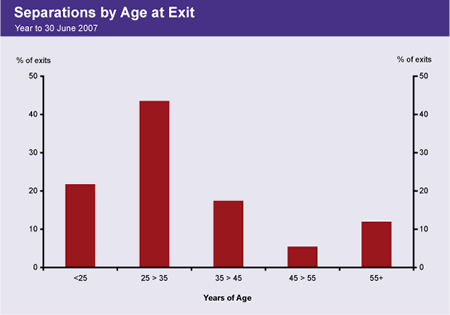Equity & Diversity Annual Report – 2007 Section 3: Human Resource Policies & Practices
Section 3.1: Recruitment & Selection
The Bank's recruitment policy and guidelines integrate equity and diversity principles into the specific goals and strategies. This helps ensure that the Bank continues to attract high calibre candidates to its graduate, cadetship and traineeship recruitment programs. A key aspect of the recruitment policy includes an equitable approach to selection of candidates; including from groups under-represented in the Bank's staffing profile. The Bank uses a range of merit recruitment strategies to attract and select a diverse field of applicants.
Several initiatives have been implemented this year addressing equity and diversity in recruitment. Recruitment and selection processes were reviewed and changes were made to ensure continued compliance with anti-discrimination legislation. The content and mode of delivery of the Selection Panel Guidelines have been revised to allow discussion of equity issues and employment needs of specific organisational areas.


There has been a continuing emphasis on attracting more female candidates to the Bank. The Graduate Development Program is still the main avenue to attract qualified women into professional and management positions in departments. The Bank has continued its participation in The Australasian Graduate Recruitment Benchmarking Survey which assists in ensuring the Bank is well informed on best practice attraction strategies.
| Year | Women | Men | Total | Ratio |
|---|---|---|---|---|
| 2007 | 11 | 30 | 41 | 27:73 |
| 2006 | 11 | 26 | 37 | 30:70 |
| 2005 | 15 | 25 | 40 | 38:63 |
| 2004 | 8 | 21 | 29 | 28:72 |
| 2003 | 8 | 26 | 34 | 24:76 |
| 2002 | 14 | 25 | 39 | 36:64 |
| 2001 | 7 | 26 | 33 | 21:79 |
| 2000 | 14 | 20 | 34 | 41:59 |
The Bank promotes a range of methods to invite applications from candidates who might not otherwise think of applying for work at the Bank. This year, online recruitment has featured more prominently as a medium to attract employees, with an increase in the use of internet job boards. Traditional methods also continue to be used to ensure that the largest possible pool of potential applicants is tapped. In order to broaden the pool of candidates for the Traineeship Program, various sources were used including relevant recruitment agencies, TAFE colleges, the internet and employment agencies representing people with disabilities and Indigenous Australians.

Additional options for recruiting more Indigenous Australians at Head Office and the business recovery site were also investigated. During the next reporting period, the Bank intends to reconsider the Commonwealth Indigenous Cadetship Program as an additional way of targeting Indigenous Australians for employment opportunities within the Bank. The Bank continues to maintain a designated traineeship position with mentoring support and will be investigating further avenues to source applicants via the Indigenous Education Program at a number of NSW high schools.
Section 3.2: Staff Training & Development
Relevant equity and diversity issues are incorporated into training and development programs provided by the Bank. In 2007, programs were reviewed to ensure that the diverse needs of staff are considered whether they are cultural, religious, or disability related. Equity policies were integrated into staff induction which now incorporates a specific module on equity and diversity issues.
In addition, a number of programs addressing diversity and cultural awareness were implemented during 2006/07. The Bank introduced English language skills training for NESB staff in the form of writing and grammar coaching conducted via group and individual sessions. To acknowledge the varying communication styles used by different cultures and to assist staff with career progression, the Technical Writing and Business Writing Programs continue to be offered with the objective of providing tailored training in written communication relevant to the workplace.
The Bank continues to monitor women's access to and participation in training activities. Women have consistently made up a high proportion of staff attending in-house training activities, and participate at a higher rate than their representation in total staff.
Springboard, an external professional development program for non-managerial women, is another program the Bank has continued to support with five women attending in 2006/07.
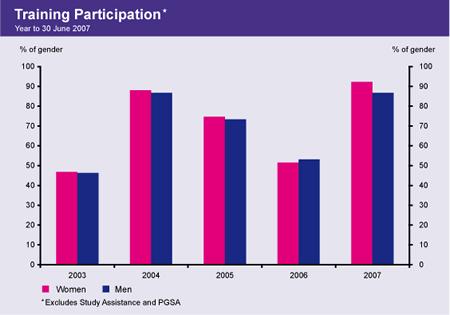
During the reporting period, thirteen members of staff attended a Disability Awareness Workshop aimed at frontline customer service staff. The purpose of the workshop was to encourage participants to develop an understanding of disabilities and assist in identifying appropriate communication strategies for customers with different types of disability. The Bank has also purchased a training package for the Bank's in-house software developers; the WebAim CD Online Accessibility Tool will help improve awareness of accessibility needs.
Graduate Development Program
The two-year Graduate Development Program continues to provide extensive training and development opportunities as well as a strong foundation for longer-term professional development. Forty one graduates, predominantly with Honours degrees, joined the 2007 program. In this reporting period, the Bank investigated a number of coaching programs for female graduates where it could enhance their prospects for advancement to management/senior management positions.
Management Programs
The Bank provides a range of management programs to its staff. During this reporting period, the Bank ran its highly-regarded Central Banking Management Program. This leadership program is designed to enhance the skills of managers through greater awareness of themselves and their staff. This was attended by a total of 14 staff (eleven men, three women). Thirteen members of staff (nine men, four women) took part in the New Managers Program, designed to provide participants with understanding of characteristics of effective leadership, team building managing cultural diversity and effective conflict resolution. As part of the Executive Development Program, the Steps program has been piloted, aiming to enhance the skills of female managers and assist with their progression to senior management.

Section 3.3: Staff Mobility: Promotions, Transfers & Secondments
Promotions, transfers and rotations within the Bank, including to overseas and regional offices, are an important means of staff development. Staff are also provided with opportunities to act in higher positions and to undertake secondments to other institutions. Over the past year, staff have worked at the Bank for International Settlements, UK Financial Services Authority, Bank of France, Australian Treasury, Australian Taxation Office, Australian Prudential Regulation Authority and Australian Securities and Investments Commission.
The Bank has the following policies and processes in place to ensure the provision of a fair and equitable method of assessment for promotion and transfer and to remove possible barriers to career mobility:
- provisions relating to equity and diversity within selection policy and guidelines;
- specified gender representation in the composition of the selection panels;
- training for selection panel members which contains information on the equity responsibilities of the panel members and the implications for the process;
- centralised job evaluation mechanisms;
- stablished criteria for assessing merit; and
- eligibility for part-time staff to apply for promotion.
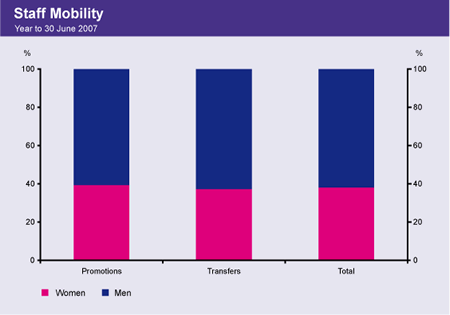
Internal mobility rates for staff continue to be monitored across all equity groups. With regard to gender, in this reporting period, the transfer and promotion rate for female staff was 37 per cent and 39 per cent respectively, comparable to their participation rate of 42 per cent. Overall, 18 per cent of all women have been transferred this year, compared to five per cent last year. These figures reflect staff movements associated with internal restructuring and staffing of the Bank's new business resumption site (BRS).
The BRS was built to provide comprehensive back up for critical Reserve Bank operations in Head Office. The Bank therefore developed a strategy to staff the BRS with appropriate skills and experience. This involved close consultation with senior personnel in relevant departments on issues of job design, determining the basis on which positions could be best filled, and training for managing remote teams. The process, while lengthy, was designed to provide a fair outcome for staff and minimal disruption to business operations. To assist with that, a BRS Intranet page was created to provide staffing information on transport links, childcare centres in the vicinity and relief arrangements. The BRS is scheduled to be fully operational in the second half of 2007, and will ultimately have a total staffing complement of 60.

Section 3.4: Remuneration
The Bank has developed a transparent and merit-based remuneration system that discourages any policies or practices that may lead to wage discrimination on the grounds of gender. The remuneration system ensures pay equity through the use of a job evaluation methodology and market benchmarking as well as an annual skill and performance review process. The Bank undertakes regular job evaluations that involve describing and articulating the roles in the Bank, comparisons with other jobs with similar work value and skill requirements and external benchmarking to ensure these jobs are properly valued and correctly remunerated.
Pay distribution continues to be monitored to see if any changes are occurring over time. An analysis of salaries of all staff, irrespective of whether staff are on individual employment contracts or are covered by the Bank's Enterprise Agreement, indicates that there is no gender inequity in pay distribution. Overall, in 2006/07 women in the Bank earned on average 99 per cent of what men earned; well above the national average of 84 per cent. Under the 2007 Enterprise Agreement, the Bank has undertaken to continue to analyse issues around pay equity.
In the following graph there are three elements requiring further explanation for women at Level 1, Level 4 and Level 7. Firstly, there are more women at Level 1 with higher tenure in the position, hence they are at the top of their salary band; secondly, the situation for Level 4 women is that a larger number of these positions are held by men in the Bank's IT area; and finally, Level 7 women generally have much shorter tenure when compared to Level 7 men.
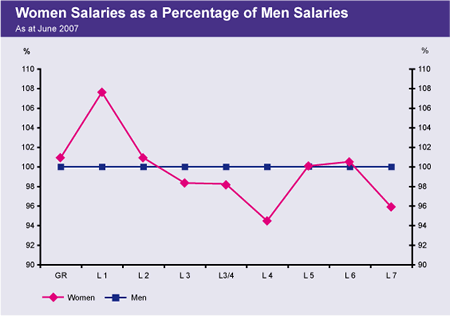
In 2006/07, average performance pay outcomes were similar for men, women, people from non-English speaking backgrounds, and people with disabilities.
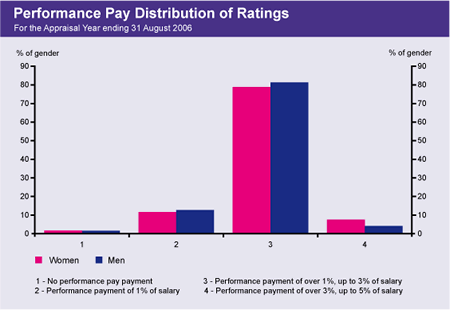
Section 3.5: Turnover
The Bank continues to monitor separation data annually to identify any adverse impact on equity groups, particularly in areas undergoing change. There were 92 separations in 2006/07, compared with 83 the previous year. Women represented 38 per cent of all staff separations in this reporting period which is comparable to their participation rate of 42 per cent. The separation rate for NESB1 staff was eight per cent, below their participation rate of 22 per cent.
The graduate turnover rate, currently 12 per cent, continues to be higher than for other staff but is still lower than the separation benchmark rate (14 per cent) for the finance sector identified in the Bank's benchmarking data; the average tenure of exited Bank graduates is 3.25 years. The total figures for graduate exits show that 54 per cent of all female graduates have resigned (79 out of 145 since 1991) compared with 52 per cent of all male graduates (172 out of 330 since 1991).
However, when the data is looked at over a shorter time period – the five years since 2002 – the average tenure of departing graduates has declined to 2.34 years with 24 per cent of all female graduates resigning compared with 27 per cent of all male graduates. Further analysis of these figures will be undertaken over the coming reporting period. Graduate retention rates will continue to be monitored with a view to identifying appropriate retention strategies, especially in relation to women where retention overall is marginally lower than for men.
The likelihood of staff staying with the Bank to retirement age is of interest to the Bank within a workforce planning context. Staffing strategies, as well as communication and work flow arrangements, need to be planned around employee movements in and out of the Bank to ensure the organisation remains effective in the long term. The changes to taxation of superannuation benefits from 1 July 2007 is a new factor that the Bank investigated during the reporting period in the context of developing a policy to cover ‘transition to retirement’ for current employees.
